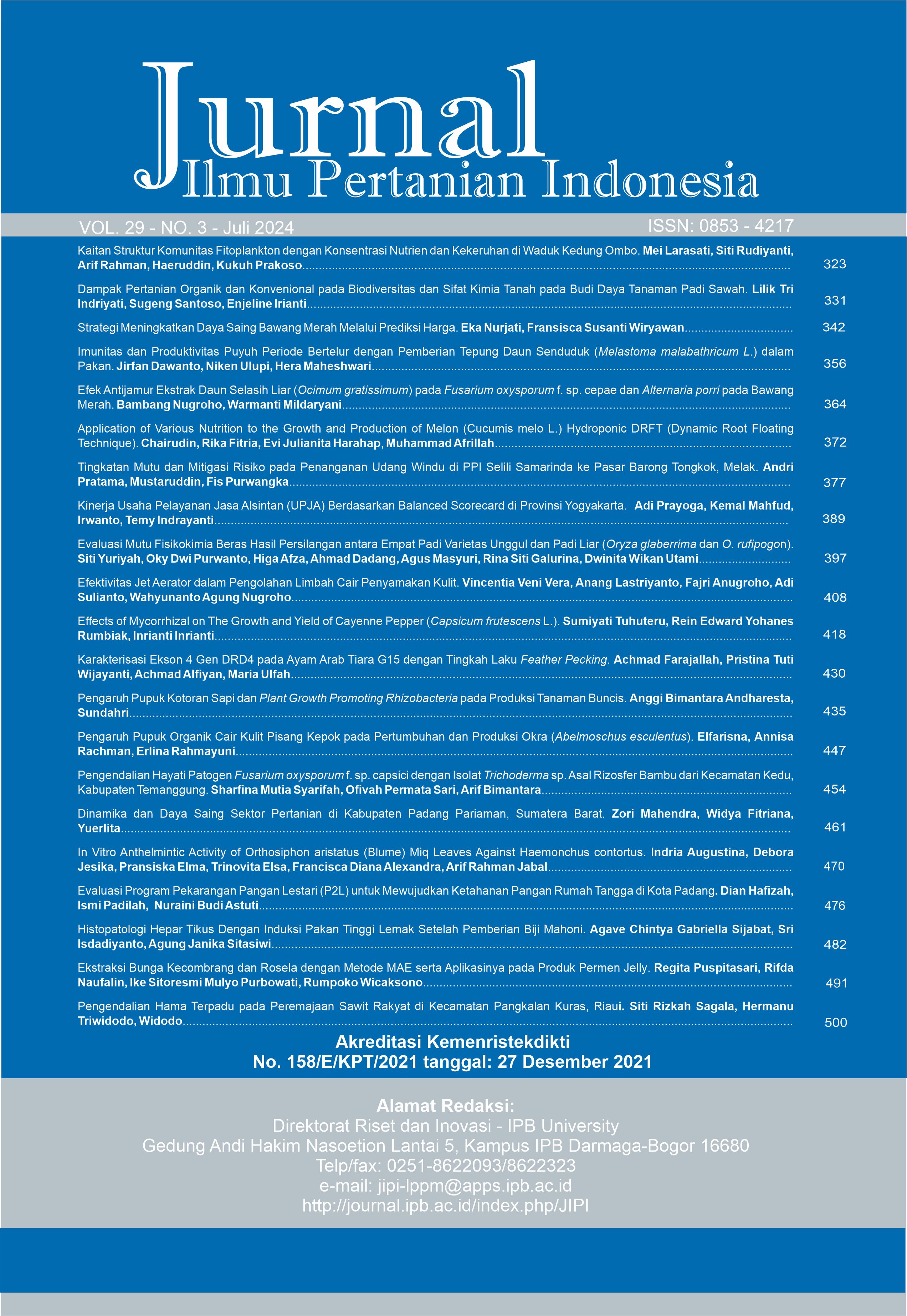Pengendalian Hayati Patogen Fusarium oxysporum f. sp. capsici dengan Isolat Trichoderma sp. Asal Rizosfer Bambu dari Kecamatan Kedu, Kabupaten Temanggung
Abstract
Wilt disease caused by Fusarium oxysporum f. sp. Capsici can cause serious problems and reduce red chili yields, so controls are needed that can reduce the development of the pathogen. The purpose of this study was to determine the potential of Trichoderma sp. from the bamboo rhizosphere in Kedu District, Temanggung Regency, in inhibiting the growth of F. oxysporum f. sp. capsici in vitro and in vivo. Trichoderma sp. Was isolated from the rhizosphere of bamboo plants, and F. oxysporum f. sp. capsici was isolated from red chili plants with symptoms of fusarium wilt. Mushroom isolates were purified and identified based on the identification key book. An in vitro test using the double culture method and an in vivo test were conducted in a screen house by applying Trichoderma sp. to the stem of red chili plants. One isolate of Trichoderma sp. was obtained from the soil of the bamboo rhizosphere in the Kedu District, and Fusarium sp. isolates were obtained from the stems of red pepper plants. Based on in vitro antagonist tests, Trichoderma sp. Fungi were able to inhibit the growth of F. Oxysporum f. sp. capsici up to 82.50% at 7 HSI. Trichoderma sp. could inhibit pathogens through antibiotic inhibition mechanisms and competition of nutrients and space to grow. Trichoderma sp. inoculation followed by in vivo inoculation of pathogens on red chili plant stems showed an attack symptom intensity of 4.16% with an antagonistic performance of 75.03% 12 days after inoculation. Trichoderma sp. is effective as an alternative biological control agent for red chili plant disease caused by F. Oxysporum f. sp. capsici.
Keywords: Bamboo Rhizosphere, Fusarium oxysporum f. sp. capsici, Plant Diseases, Trichoderma sp.
Downloads
References
Asrul, Rosmini R, Rista A, Astuti ID, Yulianto A. 2021. Karakterisasi Jamur penyebab penyakit busuk pangkal batang (basal rot) pada bawang wakegi (Allium x wakegi Araki). Agro Bali: Agricultural Journal. 4(3): 341–350. https://doi.org/10.37637/ab.v4i3.835
Berlian I, Anarqi S, Pudjihartati E. 2016. Isolasi, identifikasi dan antagonisme in vitro isolat Trichoderma spp. asal kebun karet Blimbing, Pekalongan, Jawa Tengah. Jurnal Penelitian Karet. 34(2): 201–212. https://doi.org/10.22302/ppk.jpk.v34i2.231
Jufri AF, Rahayu MS, Setiawan A. 2015. Penanganan penyimpanan kentang bibit (Solanum tuberosum L.) di Bandung. Buletin Agrohorti. 3(1): 6570. https://doi.org/10.29244/agrob.v3i1.14828
Ningsih H, Hastuti US, Listyorini D. 2016. Kajian antagonis Trichoderma spp. terhadap Fusarium solani penyebab penyakit layu pada daun cabai rawit (Capsicum frutescens) secara in vitro. Proceeding Biology Education Conference. 13(1): 814–817.
Pasalo NM, Kandou FEF, Singkoh MFO. 2022. Uji antagonisme jamur Trichoderma sp. terhadap patogen Fusarium sp. pada tanaman bawang merah Allium cepa isolat lokal Tonsewer secara in vitro. Jurnal Ilmu Alam dan Lingkungan. 13(2): xxx.
Picardal JP, Tundag EDL, Goc-ong MTPGB. 2019. Antagonistic activity of Metarhizium anisopliae (Metschnikoff) Against phytopathogenic Fusarium oxysporum f. sp. cubense (Schlecht) as a biological control antagonistic activity of Metarhizium anisopliae (Metschnikoff) against phytopathogenic fus. CNU Journal of Higher Education. 13: 25–33.
Putra IMTM, Phabiola TA, Suniti NW. 2019. Pengendalian penyakit layu Fusarium oxysporum f. sp. capsici pada tanaman cabai rawit Capsicum frutescens di rumah kaca dengan Trichoderma sp. yang ditambahkan pada kompos. E-Jurnal Agroekoteknologi Tropika. 8(1): 103–117.
Sundari A, Khotimah S, Linda R. 2014. Daya antagonis jamur Trichoderma sp. terhadap jamur Diplodia sp. penyebab busuk batang jeruk siam (Citrus nobilis). J. Protoniont. 3(2): 106–110.
Susanti A, Afifah N, Febrianti R. 2021. Penekanan jamur endofit terhadap patogen pada tanaman jambu bol Gondang Manis. J. Viabel Pertanian. 15(1): 12–26.
Sutarman. 2017. Pengujian Trichoderma sp. sebagai pengendali hawar daun bibit kakao yang disebabkan oleh Phythopthora palmivora. J HPT Tropika. 17(1): 45–52. https://doi.org/10.23960/j.hptt.11745-52
Syahputra MH, Anhar A, Irdawati. 2017. Isolasi Trichoderma spp. dari beberapa rizosfer tanaman padi asal Solok. J Biosains. 1(2): 97–105.
Wulandari TN, Saridewi TR, Dayat. 2020. Peningkatan kapasitas petani dalam pengendalian organisme pengganggu tanaman pada budi daya cabai merah di Kecamatan Tugumulyo Kabupaten Musi Rawas. J Inovasi Penelitian. 1(3): 647–658. https://doi.org/10.47492/jip.v1i4.147
You J, Zhang J, Wu M, Yang L, Chen W, Li G. 2016. Multiple criteria-based screening of Trichoderma isolates for biological control of Botrytis cinerea on tomato. J Biological Control. 101: 31–38.
Copyright (c) 2024 Sharfina Mutia Syarifah

This work is licensed under a Creative Commons Attribution-NonCommercial 4.0 International License.
This journal is published under the terms of the Creative Commons Attribution-NonCommercial 4.0 International License. Authors who publish with this journal agree to the following terms: Authors retain copyright and grant the journal right of first publication with the work simultaneously licensed under a Creative Commons Attribution-NonCommercial 4.0 International License. Attribution — You must give appropriate credit, provide a link to the license, and indicate if changes were made. You may do so in any reasonable manner, but not in any way that suggests the licensor endorses you or your use. NonCommercial — You may not use the material for commercial purposes.























